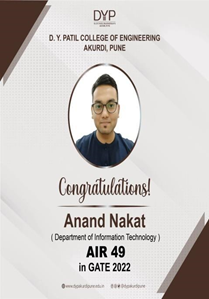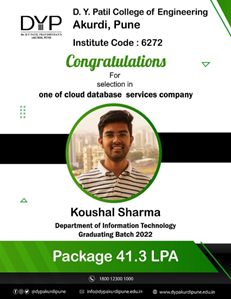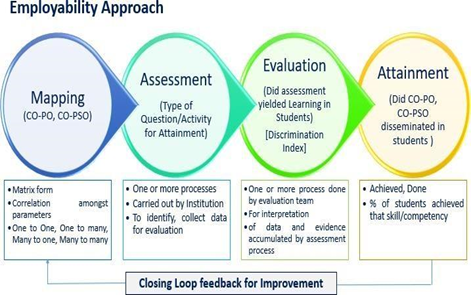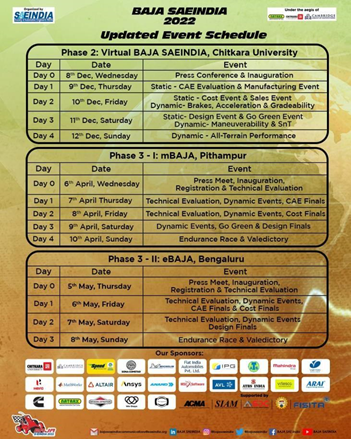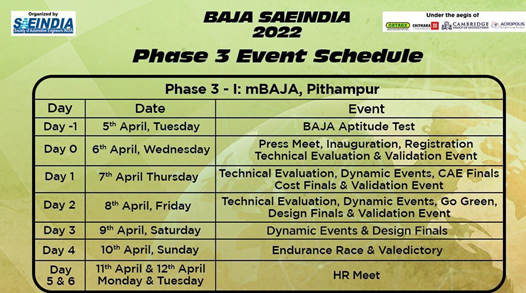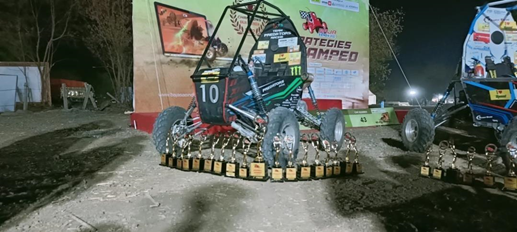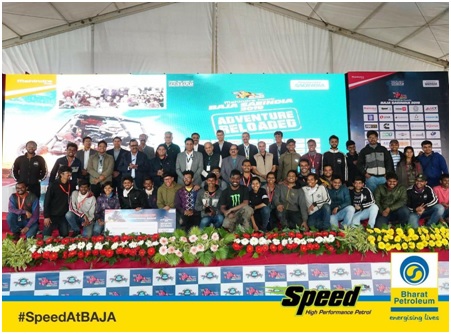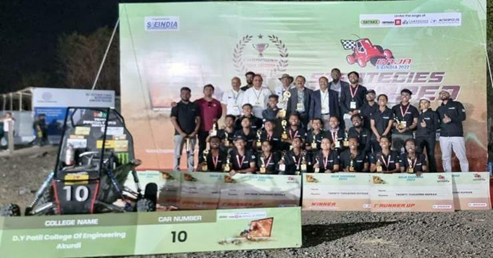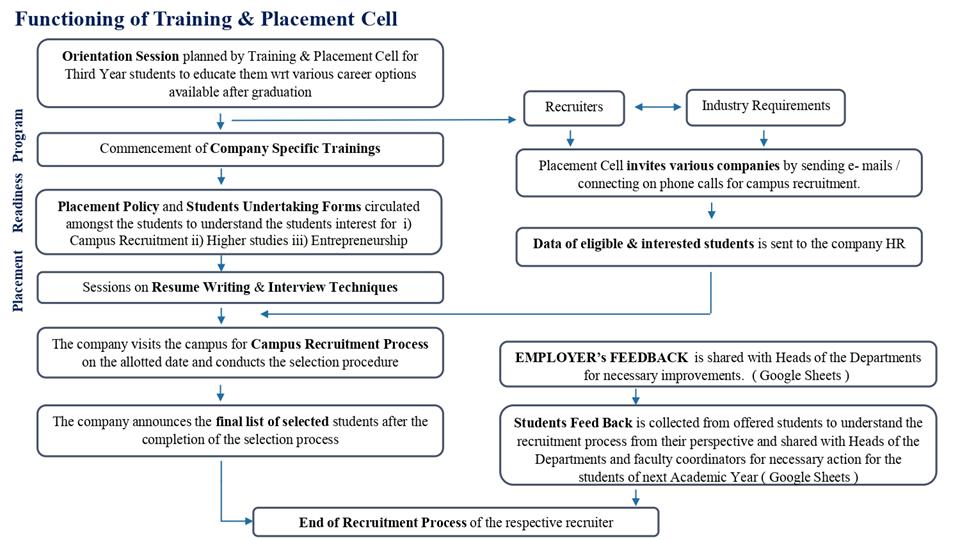About DYPCOE
Dr. D. Y. Patil Prathishthan's, D.Y. Patil College of Engineering, was established in 1984 in Pimpri and later shifted to Akurdi complex in 2001, which is in the vicinity of Pimpri Chinchwad Industrial area, one of the biggest Industrial belts in Asia. The college spreads over 10 acres of land with seven Engineering disciplines. This Institute is approved by AICTE, New Delhi and is affiliated to the Savitribai Phule Pune University.
The college has excellent & ambient infrastructure with well-equipped laboratories. Well-qualified, motivated, and dedicated faculty members are serving in the Institute. Students are encouraged to actively participate in National and State level co-curricular and extracurricular activities. The institute has well planned boys and girls hostel in the campus with better amenities and ultra-modern facilities.
Branchwise intake
Branch wise Intake
|
Under Graduate Level(First year Engineering) |
Intake |
Post Graduate Level |
Intake |
|
Civil Engineering |
120 |
Civil Engineering · Construction & Management · Environmental Engineering |
18 18 |
|
Computer Engineering |
180 |
Computer Engineering |
13 |
|
Electronics & Telecommunication Engineering |
180 |
Electronics & Telecommunication Engineering · VLSI & Embedded Systems |
9 |
|
Information & Technology |
180 |
NA |
NA |
|
Instrumentation & Control Engineering |
60 |
NA |
NA |
|
Mechanical Engineering |
120 |
Mechanical Engineering :Mechanical Design |
18 |
|
Production Engineering (Sandwich) *(From Second Year(SE) to Final Year (BE)) |
60 |
Robotics and Automation |
15 |
|
BE : Artificial Intelligence and Data Science |
180 |
||
|
BE : Robotics and Automation |
60 |
HIGHLIGHTS:
- Established in 1984
- Approved by AICTE, New Delhi
- Affiliated to Savitribai Phule Pune University
- Highly qualified and competent faculty
- Ultra-modern buildings and excellent infrastructure
- Well-equipped laboratories
- NRI quota as per AICTE norms
- Research and Consultancy Cell
- 100% placements through training and placement cell
- Environmental Impact Assessment Cell
- Highly enriching library facility including Internet, National and International journals
Excellence through Education:
Appreciated and recognized as a front runner in the education scenario. The D Y Patil College has become a prominent force in imparting quality education. The group strongly believes that quality education is a stepping stone to progress and success. With a long standing commitment towards quality teaching and learning, the group has nurtured values that go into the making of successful careers. Reiterating excellence in every venture explored, the group stands tall with its undeterred commitment to deliver quality education. Equipped with state of the art infrastructure, the group has a chain of 100 educational institutions that encourage individuals to think, question, explore and apply their well-honed minds to scale the newer heights of success. The college believes in imparting education that will build world citizens of tomorrow. Therefore it has ventured and excelled in uncommon streams like engineering, management, research and technology.
Moreover the college enjoys academic alliances with overseas universities that help to breach the educational and cultural divide between various and countries and us.
Code of conduct policy
Code of conduct policy
Policy No 4: Academic Discipline and Code of conduct
Policy 4.1 Code of Conduct for students
Entities affected by this policy – All the students of DYPCOE.
Policy Statement – Following are the codes of conduct for the students of the Institute
Responsible Office – All the academic departments of DYPCOE
Dates of issue: Oct. 2019
Policy 4.2 Code of Conduct for Faculty and Staff
Entities affected by this policy – All the faculty and staff of DYPCOE.
Policy Statement – Following are the codes of conduct for the
Best Practices 1
Institute Best Practice-1 |
Best Practice 1
|
Title of the practice: |
Holistic Development of Students for Higher Package Jobs by formulation of PSO mapping and attainment aligned with Alumni Profiles |
||
|
Objective of the practice: |
1. To train the students and to enhance quantitative and qualitative aptitude. 2. To provide a platform to the students for showcasing their technical knowledge as per the needs of the industry. 3. To provide good offers through corporate cell of Institute during campus recruitment 4. To make students aware of alumni profiles and prepare them as per industrial requirement. 5. To appraise students the skills and competencies required to fulfill in market. |
||
|
The Context: |
The Institute concentrates on work integrated learning through training and placement cell in equipping new graduates with the required employability skills. Student’s participation in internship gives them confidence and motivation through stipend. CO-Learning strategy is adopted for internship, which helps students to learn newer methods, cutting edge technologies and employability opportunities in the future to build upon. Third Year students were trained by external agencies like Campus credentials and Ethnus based on Aptitude test skills, technical coding skills, company specific questions and Resume writing etc. The Institute enhances industry-institute interface, networking within the industry for placement and training interventions for enhancing student’s capability. Program Outcomes are developed in students through alumni expert sessions. OBE - outcome-based education focuses on making students employable. Any professional degree education's end conclusion or net result can be evaluated by either placement (on campus, off campus, higher education), or entrepreneurship.
|
||
|
The practice: |
OBE for Teaching Learning process: Students and faculty members have completed certifications and value-added programs for gap fulfillment with respect to Industry requirements.Faculty has been playing a vital role in guiding and mentoring students to select the right choice of courses and further counsel them to prepare for placement and higher education selection process. The impact of the guiding and mentoring system observed as this scheme helps to reduce productive wastage of time that otherwise can be utilized for learning by students. Institute offers employability skills development training programs from high repute third party vendors during their TE. Alumni are strong assets of the Institute. Departments and T&P cells have consistently arranging various activities to cater the students as per the upcoming need of the Industry in advanced technologies. Technical activities are organized under various Professional Bodies and Students Association to groom the students and make them technically competent. Google Developer Student Club is established in the Institute from 2020 to train and learn technologies of Google platforms to the students of all departments. Core areas are always specific to each program like Manufacturing, Design in Mechanical Engineering, Sensors and Embedded systems in Electronics, construction in Civil engineering and likewise. Broad areas consist of core along with the other areas of working which can be seen mostly through the alumni profile. Similar to the basic areas of computer engineering are Web and Software development, Communication, Programming, Networking while broadened fields include signal processing, high performance computing, embedded systems, VLSI design, and many inline disciplines.
Depth of T = Alumni’s working in Core area / Total No. of alumni's. The percentage of depth refers to the number of curricular gaps needed to meet PO and PSO requirements. Opportunities in the program are growing when broad regions are shallower than core areas. else it will be diminishing accordingly. Participation of Alumni’s profile will be considered for PSO formulation Pros of designing PSOs based on alumni characteristics include - 1. Adoption of the alumni growth trend line in OBE. 2. To educate teachers about the problems faced by alumni as a result of changes in skills and competencies and technological advancements in the business world. 3. Whether the Present skills and competencies developed in the students are aligned with alumni profiles or not can be outlined through the CO-PSO Mapping. 4. Encourage educators to create lesson plans and pedagogy that will help |
||
|
Evidence of success: |
Following are the statistics of higher packages received for students during the placement of academic year 2022.
|
|
|
Below are some evidences of success of higher package students:
Following are the PSO statements framed through the case study conducted from Electronics alumni. 1. PSO1 (A few key categories delineated from Alumni Profiles recruited during UG course placements): Graduates design, test, and validate time switches, timers, PLCs, GSM controllers, temperature controllers, signal transducers, modular power supplies, and instrumentation devices in the electronics industries. They also embed software engineers or train to be software engineers in the transportation sector, along with network planning engineers for all long-distance routes in the country. 2. PSO2 (Some of the significant areas noted in the Alumni Profiles of those who continued their studies after completing their UG): to improve analytical, computational, and computationally intensive problem-solving abilities in the fields of electronic circuits, communication, signal processing, and control systems. 3. PSO3 (Some of the key industries where alumni launched their businesses): Graduates launch their businesses in industries like website development, renewable energy, and digital branding, among others.
|
|
Problems Encountered and Resources Required: |
As students were well aware about the market scenario and competition lined up for them in this corporate world, considering this in mind, students were expecting more such training. Also students should be trained using some hands-on training or through visits to industrial premises or Corporate world. Students were not aware of the advantages of such a method. Therefore, initially students were made aware of curriculum gaps and bloom’s taxonomy level requirements to enhance their employability. This has helped to overcome the thinking of students who were considering assessment as a burden. Also, to make calculations of each outcome, were lengthy and susceptible for fatigue by faculty. Therefore, software named attainDI was developed and made available on the website. |
Best Practices 2
Institute Best Practice-2 |
|
Title of the practice: |
To inculcate Entrepreneurship, Project Designing, Project Manufacturing, Team Working skills through co-curricular activities such as BAJA SAEINDIA. |
|
Objective of the practice: |
|
|
The Context: |
Co-curricular activities aid in the holistic growth of students and the acquisition of vital competencies needed for success including Intellectual, physical, emotional, and social growth, which can only be attained through quality education. Co-curricular activities like BAJA SAEINDIA play a significant role in the growth of social and emotional skills, among other aspects of persona. All India SAE BAJA competition was held at Pithampur-M.P, from 6th April to 10th April 2022. For BAJA SAEINDIA 2022, 214 entries from various engineering colleges in India were received, of which 138 teams have registered for the m-BAJA event and 76 teams have enrolled for the e-BAJA event. Students at BAJA SAEINDIA are required to conceptualize, design, build, test, and verify a single-seater all-terrain vehicle (ATV) in order to participate in a number of activities. |
|
|
Fig: 7.2.4: BAJA Event Schedule |
|||
|
The practice: |
Phase 1 - Preliminary Round, BAJA SAEINDIA 2022 The virtual presentation of the teams' ATVs was the main emphasis of the first leg (Phase 1), also known as the preliminary round, which was held in August 2021. The purpose of the Preliminary Round was to gauge teams' technical and professional prowess on an online forum.
Phase 2 - Virtual Round, BAJA SAEINDIA 2022 For the 2022 iteration, the second leg did include digital static events in conjunction with virtual dynamic events created with the aid of automotive simulation software. The virtual evaluation of static events, such as design, cost, manufacturing, and sales presentation, as well as dynamic events, like acceleration, gradeability, braking, suspension & traction, and maneuverability, are both included in phase 2.Through IPG CarMaker, a globally renowned automotive simulation program, All Terrain Performance is digitally maintained. The purpose of these competitions is to assess the teams' business acumen, cost-effectiveness, software knowledge, and comprehension of design.
Phase 3 - Physical Round, BAJA SAEINDIA 2022 Phase 3, the last phase, is planned to take place physically in Pithampur (for mBAJA) in April 22 and Bangalore (for eBAJA) in May 22. The primary purpose of this phase was to physically assess the buggies created by the different competing teams. Along with the initial technical assessment, this part included a number of dynamic events, including maneuverability, acceleration, suspension and traction, and endurance. |
|||
|
|
Fig: 7.2.5: BAJA Event Phase 3 Schedule
Team member details: |
|||
|
|
Name of Student |
Year- Branch |
|
|
|
Neel Kapadi |
BE Mech |
|||
|
Vipul Jadhav |
BE Mech |
|||
|
Ali Abu Farjad |
BE Mech |
|||
|
Pratik Biradar |
BE Mech |
|||
|
Pruthviraj Shinde |
BE Mech |
|||
|
Saurabh Shingare |
BE Mech |
|||
|
Sudip Chavan |
TE Mech |
|||
|
Anuj Tembugade |
TE Mech |
|||
|
Aryan Kesharwani |
TE E&TC |
|||
|
|
|
MrunalDaudkar |
BE E&TC |
|
|
Vikaskumar Singh |
TE Mech |
|||
|
YashodeepHimmatrao Patil |
TE Mech |
|||
|
Nilesh Arjun Bhopale |
TE Mech |
|||
|
Gauri Rajesh Kharche |
TE Mech |
|||
|
AbararJaved Patel |
TE Mech |
|||
|
PrathameshSarjerao Pawar |
SE Mech |
|||
|
Yash SheshkumarMalusare |
SE Mech |
|||
|
Mandar Shantaram Mali |
SE Mech |
|||
|
Shantanu Satish Patil |
SE Mech |
|||
|
Swarali Santosh Gulwade |
SE Mech |
|||
|
Faculty Adviser: Mr. Vaibhav Phule Note:Mr Vinod Hiwase was present as faculty Adviser during event due to health issue to Mr. Vaibhav Phule. Event Details: From April 6 to April 10, 2022, the D. Y. Patil College of Engineering in Akurdi's BAJA "Team Predators Racing" competed in the BAJA SAE India tournament. Result: Team Predators Racing From DYPCOE, Akurdi secured an All-India Rank 1 with 17 different Awards. |
||||
|
Evidence of success: |
Fig: 7.2.6: BAJA Vehicle
List of Awards is as follows: Virtual Awards Overall Virtual Dynamic - 1st Overall Static-2nd Manufacturing - 1st Cost - 1st Engg and Design - 1st
1. Suspension and Traction - 1st 2. Virtual Brake performance – 2nd 3. Virtual Maneuverability- 2nd 4. Virtual Acceleration - 2nd Physical Awards 5. Dynamic Acceleration -1st 6. Dynamic Maneuverability - 1st 7. Dynamic Suspension and Traction - 1st 8. Durability - 1st 9. Overall Dynamic test - 1st 10. Physical Dynamic -Acceleration – 1st 11. Physical Dynamic -Maneuverability– 1st 12. Suspension & Traction - 1st 13. Durability – 1st 14. Overall Dyanamic Test – 1st 15. Raftar – 1st 16. Sled Pull – 2nd 17. 4WD Transmission – 3rd Overall All India Rank-2 Year 2019 Fig: 7.2.8: BAJA All India Rank 1 Year 2019
Overall All India Rank-2 Year 2021 Fig: 7.2.8: BAJA All India Rank 2 Year 2021
Overall All India Rank-1 Year 2022 Fig: 7.2.8: BAJA All India Rank 1 year 2022
Overall All India Rank-1 year 2023 Fig: 7.2.8: BAJA All India Rank 1 year 2023
|
|
Problems Encountered and Resources Required: |
Problem encountered: 1. Funding for SAE India 2021 event : Rs 2,00,000/- received as CSR from Jendamark India Private Limited 2. AU mechanical engineering software required for Design, analysis and Simulation: Provided by Altair engineering Resources for BAJA: 1. DYPCOE Workshop for Vehicle manufacturing 2. Dehu Road Cantonment: For Testing of Vehicle 3. MSC Software Corporation India Private Limited: Romax software module CAD fusion for Analysis 4. MathWorks Student Competition Team: MATLAB and Simulink Software for simulation 5. 3D Design and Engg Software Dassault systems : Solidworks software for designing |
Institutional Distinctiveness




